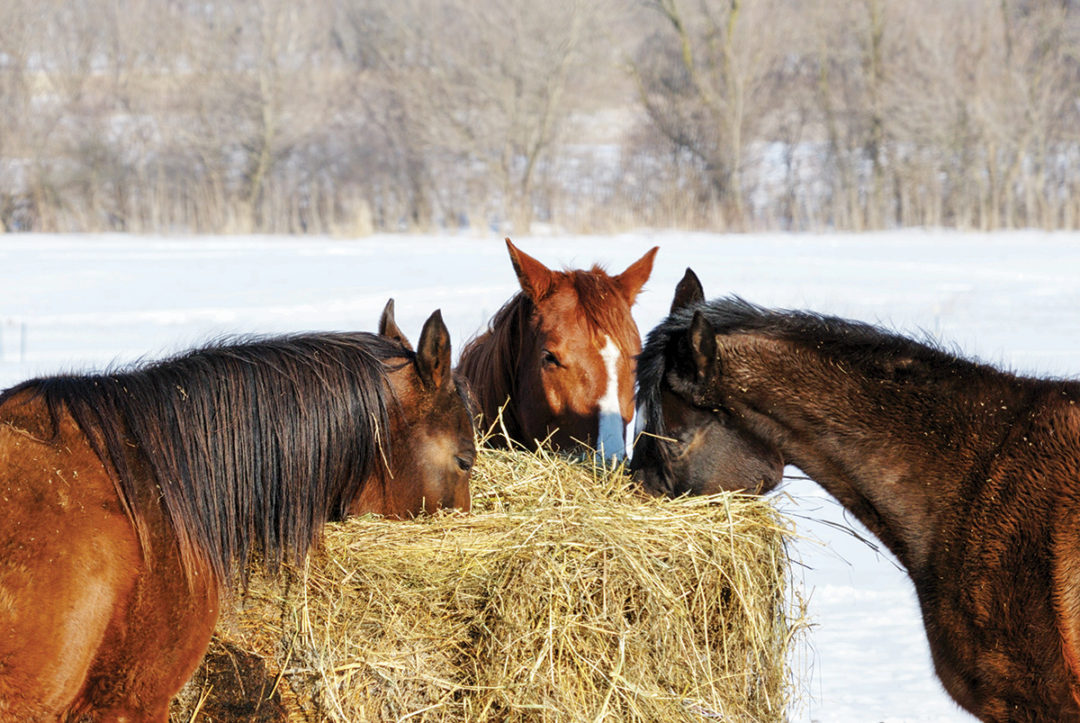As I type this, my shoulders are admittedly sore from us hauling hay over the past week to prepare for the winter ahead – but in a year of horrible drought impacting much of our country, I’ve never felt more grateful for the feeling. As the weather begins to chill, there’s quite a bit of preparation required to care for impressively stout, yet entirely fragile horses. Let’s go through some facts about winter equine nutrition to help horses weather the winter as well as possible.
Fact 1: “Many horse owners may not realize they actually need to feed horses differently in the wintertime than they do in the summertime,” says Jyme Nichols, director of nutrition at Stride Animal Health. “The first thing I think is important for everybody to understand is a term that sounds a little bit intimidating – thermoneutral zone. This is basically the temperature outside in which a horse can maintain their own core body temperature without having to exert any extra effort to regulate either their heat loss or heat gain.”
Fact 2: Horses in the U.S. have an average thermoneutral zone between 40ºF and 80ºF, which means horses near the low end of their thermoneutral zone will have to use extra energy (and therefore extra calories) to maintain heat.
Fact 3: A horse’s feed sources will help them maintain warmth, in addition to weight. Nichols explains, saying, “Think of a horse’s digestive system, or their hindgut, as a furnace. The more the microbes in the horse’s hindgut are able to digest and ferment – especially fibers – the more heat that can be generated for that horse. That's part of what goes into keeping them warm.”
Fact 4: As weather changes, so should a horse’s diet, but not in the way some may think. While horse owners may mean well, increasing grain can be harmful to a horse’s health, heightening colic risk and more. Also, doing so may not be enough to help a horse maintain their warmth when they need it most. “Increasing the amount of hay is the best way to increase heat production and keep a horse warm during winter,” Nichols says. “Horses will naturally increase the amount of hay they eat based on the temperatures dropping.”
Regarding how much more hay to provide, remember that the average thermoneutral zone for horses in the U.S. is between 40ºF and 80ºF. Nichols says, as a general rule of thumb, for every 1 degree Fahrenheit below the lower range of 40ºF, horses will need an extra 200 calories. “So, to put that in perspective, your average hay is going to have between 800 to 1,000 calories per pound. Let's say you've got a 10-degree drop – you're going to need an extra 2,000 calories. All I did there was just take that 10 degrees times 200 calories, and that gets me to 2,000 calories, which is roughly 2 to 3 pounds extra hay per day. So if you're feeding small square bales of grass hay, that's probably going to be an extra flake, maybe an extra two flakes.”
Fact 5: Horse owners will need to increase their horses' hay intake, but what about their grain? When the temperatures drop, upping feed is a common practice, but not recommended. Doing so will not provide horses with long-term heat production like hay does. Additionally, corn and oats are high in starches and sugars, which puts a heavy load of sugar on the digestive tract that the small intestine can't digest very well, very quickly. You can then have an overspill of starch into the hindgut of the horse, impacting the balance of the good bacteria in that gut and presenting colic issues. It can also cause founder or laminitis issues in some horses.
Fact 6: If you're going to up anything, the most important thing to do is up the hay. For senior horses or horses with poor dental conditions, consider feeding forage pellets, such as timothy or alfalfa hay pellets, or even beet pulp shreds, which all have similar benefits as long-stem hay forage.
Fact 7: “For horses who are underweight, it is important to try to improve their body condition, which will support their thermoregulation and overall health. In addition to increasing their total hay intake, we recommend adding a high-quality protein and energy supplement to help support healthy weight gain,” says Tony Hawkins, technical service veterinarian at Valley Vet Supply.
Bundle up, and keep in mind these facts to help your horses this winter.










